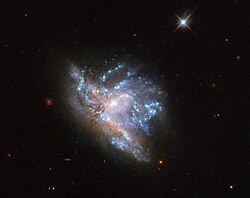NGC 6052
| Galaxie NGC 6052 | |
|---|---|
(c) ESA/Hubble, CC BY 4.0 | |
| Aufnahme des Hubble-Weltraumteleskops, NGC 6052-1 (m.)/ NGC 6052-2 (li.) | |
| AladinLite | |
| Sternbild | Herkules |
| Position Äquinoktium: J2000.0, Epoche: J2000.0 | |
| Rektaszension | 16h 05m 13,0s[1] |
| Deklination | +20° 32′ 32″[1] |
| Erscheinungsbild | |
| Morphologischer Typ | Sc+Sc / LIRG[1] |
| Helligkeit (visuell) | 1: 13,8 mag 2: 13,3 mag[2] |
| Helligkeit (B-Band) | 1: 14,5 mag 2: 14,1 mag[2] |
| Winkelausdehnung | 1: 0′,9 × 0′,7 2: 0′,8 × 0′,3[2] |
| Positionswinkel | 1: 171° 2: 175°[2] |
| Flächenhelligkeit | 1: 13,1 mag/arcmin² 2: 11,6 mag/arcmin²[2] |
| Physikalische Daten | |
| Zugehörigkeit | LGG 403[1][3] |
| Rotverschiebung | 0,015808 ± 0,000003[1] |
| Radialgeschwindigkeit | (4739 ± 1) km/s[1] |
| Hubbledistanz H0 = 73 km/(s • Mpc) | (216 ± 15) · 106 Lj (66,3 ± 4,6) Mpc [1] |
| Geschichte | |
| Entdeckung | William Herschel Albert Marth |
| Entdeckungsdatum | 11. Juni 1784 2. Juli 1864 |
| Katalogbezeichnungen | |
| NGC 6052, 6064 • UGC 10182 • PGC 57039 • CGCG 137-032 • MCG +04-38-022 • IRAS 16030+2040 • KUG 1603+206 • 2MASX J16051287+2032326 • Arp 209 • Mrk 297 • VV 86 • GC 4161, 5802 • H III 140 • | |
NGC 6052 (auch bekannt als Mrk 297, Arp 209 und VV 86) ist eine etwa 216 Millionen Lichtjahre entfernte, leuchtkräftige Infrarotgalaxie (LIRG) im Sternbild Herkules am Nordsternhimmel. Es handelt sich um zwei verschmelzende Galaxien (NGC 6052-1/2). Im Infraroten erreicht das Objekt eine Leuchtkraft von 1111 L☉.
Halton Arp gliederte seinen Katalog ungewöhnlicher Galaxien nach rein morphologischen Kriterien in Gruppen. Diese Galaxie gehört zu der Klasse Galaxien mit Unregelmäßigkeiten, Absorption und Auflösung.
Das Objekt wurde 1864 vom deutschen Astronomen Albert Marth entdeckt und ist im New General Catalogue (NGC 6052) verzeichnet. Der Eintrag NGC 6064 im NGC bezieht sich ebenfalls auf dieses Objekt; dieser Eintrag geht auf eine Beobachtung von dem deutsch-britischen Astronomen Wilhelm Herschel vom 11. Juni 1784 zurück.[4]
NGC 6052-Gruppe (LGG 403)
| Galaxie | Alternativname | Entfernung/Mio. Lj |
|---|---|---|
| NGC 5975 | PGC 55739 | 200 |
| NGC 6008 | PGC 56289 | 222 |
| NGC 6020 | PGC 56467 | 197 |
| NGC 6052 | PGC 57039 | 216 |
| NGC 6030 | PGC 56750 | 201 |
| NGC 6032 | PGC 56842 | 196 |
| NGC 6060 | PGC 57110 | 203 |
| NGC 6073 | PGC 57353 | 212 |
| IC 1132 | PGC 55750 | 206 |
| PGC 57125 | UGC 10197 | 211 |
| PGC 56636 | UGC 10127 | 221 |
| PGC 57199 | UGC 10211 | 199 |
| PGC 57117 | CGCG 137-37 | 202 |
Weblinks
Literatur
- Jeff Kanipe und Dennis Webb: The Arp Atlas of Peculiar Galaxies – A Chronicle and Observer´s Guide, Richmond 2006, ISBN 978-0-943396-76-7
Einzelnachweise
Auf dieser Seite verwendete Medien
(c) ESA/Hubble, CC BY 4.0
Colliding galaxies
Located in the constellation of Hercules, about 230 million light-years away, NGC 6052 is a pair of colliding galaxies. They were first discovered in 1784 by William Herschel and were originally classified as a single irregular galaxy because of their odd shape. However, we now know that NGC 6052 actually consists of two galaxies that are in the process of colliding. This particular image of NGC 6052 was taken using the Wide Field Camera 3 on the NASA/ESA Hubble Space Telescope.
A long time ago gravity drew the two galaxies together into the chaotic state we now observe. Stars from within both of the original galaxies now follow new trajectories caused by the new gravitational effects. However, actual collisions between stars themselves are very rare as stars are very small relative to the distances between them (most of a galaxy is empty space). Eventually things will settle down and one day the two galaxies will have fully merged to form a single, stable galaxy.
Our own galaxy, the Milky Way, will undergo a similar collision in the future with our nearest galactic neighbour, the Andromeda Galaxy. Although this is not expected to happen for around 4 billion years so there is nothing to worry about just yet.
This object was previously observed by Hubble with its old WFPC2 camera. That image was released in 2015.
Credit:
ESA/Hubble & NASA, A. Adamo et al.
Coordinates Position (RA): 16 5 12.53 Position (Dec): 20° 32' 30.43" Field of view: 1.62 x 1.28 arcminutes Orientation: North is 45.0° left of vertical
Colours & filters Band Wavelength Telescope Optical U 336 nm Hubble Space Telescope WFC3 Optical B 438 nm Hubble Space Telescope WFC3 Optical V 555 nm Hubble Space Telescope WFC3 Optical H-alpha 665 nm Hubble Space Telescope WFC3 Optical I 814 nm Hubble Space Telescope WFC3.

